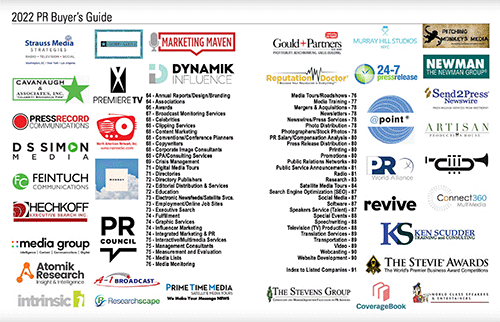 Shel Lustig |
Working with clients doesn’t always go as anticipated. You might’ve had to endure production delays, client approval drama, strategy issues and missed deadlines. These issues can be both frustrating and discouraging.
However, through my experience working with public relations professionals on their radio campaigns for nearly 30 years, I’ve learned some basics that will make any project proceed more smoothly.
Here are a few of the tips I recommend to anyone working in PR and marketing who’s seeking optimum results for their clients.
Scope of project
Define the scope of the project upfront — it’s critical to everyone involved. No one likes “scope creep,” so it’s best for everyone to understand its exact parameters — what’s included and what’s not. With all eyes focused on results, a clear direction and a discussion of these expectations will help everyone involved know the requirements for a successful outcome. A good radio broadcast vendor will provide guidance on everything from the messaging to how it might be best pitched, placed or distributed, so walk your client through the scope of the project from the very beginning. Explain what the project includes, the “why” behind each approach and, finally, what is not included.
The timeline
A well-planned production schedule is essential to running a successful broadcast campaign. Because each step is dependent on the next for success, one delay can create a rippling negative effect on subsequent steps.
At the beginning of the project, be sure your vendor creates a project schedule, which I like to walk my clients through, item by item, to ensure each component is clear. It is important to maintain open communication in this phase with your clients. Take them through each step of the project and clarify both your and their expectations. Clients should understand not only their approval deadlines, but when they’ll receive their deliverables. The final approval deadline is extremely important. Missing it may mean you won’t get on the air when you planned to.
Following a clearly defined schedule not only helps you, but everyone benefits from an efficient process that avoids last-minute runarounds. The result is a happy client.
Content
Choosing the most effective content is obviously important to the success of the campaign. Has your client acquired new data from a survey? Or, are there new discoveries that signify a big breakthrough in the product or service? Your radio partner can help you curate the message before the writing and production stage gets underway.
Depending on the target audience, the content style can be entertainment-focused, feature focused or news-focused. An entertainment-focused piece is best for morning-drive radio personalities. Features don’t need hard news but should have consumer interest, and are often used to close a newscast. Hard news is best pitched to news directors or producers. If your message includes new information, relevant statistics or an event that hasn’t yet been reported, a station is more likely to include it in its broadcasts.
Maximizing reach via distribution options
If the story is extremely newsworthy or holds high entertainment value, it likely will do well as a pitched story, and is more likely to be shared, on-air and online. However, if it’s not highly entertaining, newsworthy or if it’s too heavily branded, guaranteed or paid placement is the perfect option for getting your story on the air. This ensures the controlled message will reach a specific, significant guaranteed listenership.
Choosing the right venue
Each client, project and story is unique, so choosing the right venue to communicate the message goes a long way. Consult with your vendor on whether it might work best as an audio news release, a PSA (not-for-profit messages) or a radio media tour. Should it be pitched or placed? Think of the venue as finding the best tool for the job. Your vendor can help you understand your options. We created an infographic on the MediaTracks.com blog that demonstrates the different elements of these choices in an easy-to-understand format.
Ongoing communication
Maintaining communication may be one of the most important tips for a successful outcome. Be open to communicating frequently. In fact, having too much communication is far better than too little. Connecting often is critical to achieving each deadline and milestone. So, immediately share your client’s thoughts and feedback with your vendor. If obstacles arise, share those as well. A good broadcast partner will help you understand your options in any situation, so you can choose the best solution and keep your client up to date.
Supplying clients with a weekly update, even if it’s simply a brief email, goes a long way, too. This demonstrates that you’re attentive and closely monitoring the progress of the project. Updates help build trust and credibility with clients, and may help you secure a commitment for future business.
Deliver the results
At the completion of the campaign, we always create a comprehensive report of the results, then schedule a call to guide our clients through it, which is a process you should employ as well. Walking clients through results helps them understand audience measurement, the terminology of broadcast outreach and ROI. This step helps them understand the actual value of their investment in broadcast outreach.
Following these steps will improve broadcast project outcomes. When each step of the timeline is completed on schedule, the entire project runs more efficiently and cost-effectively. Avoiding delays reduces stress and saves time, money and headaches. Most importantly, by meeting expectations and delivering outstanding results, you’ll have a happy and recurring client.
Rely on your radio partner by leveraging their knowledge and experience. They will help you make good choices within the wide range of broadcast options available.
If you have any questions, please feel free to reach out to me at [email protected] or at 847/299-9500.
***
Shel Lustig is President and Co-Founder of MediaTracks Communications in Chicago.



 SaaS platforms now allow businesses to effectively manage and execute their own PR campaigns, putting pressure on agencies to demonstrate the value of the “traditional” PR model.
SaaS platforms now allow businesses to effectively manage and execute their own PR campaigns, putting pressure on agencies to demonstrate the value of the “traditional” PR model. Developing a well-designed TV campaign involves asking three important questions.
Developing a well-designed TV campaign involves asking three important questions. How a "Covid silver lining" can show the way to more effective, cost-efficient video communications.
How a "Covid silver lining" can show the way to more effective, cost-efficient video communications.


 Have a comment? Send it to
Have a comment? Send it to 
No comments have been submitted for this story yet.